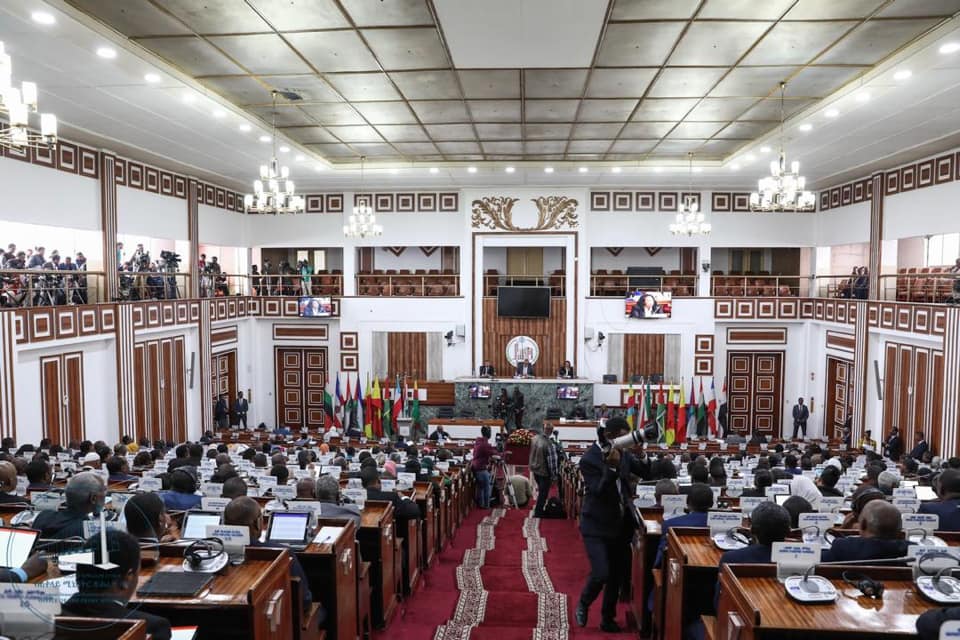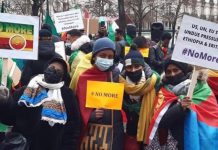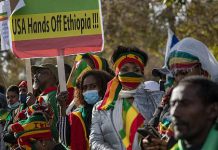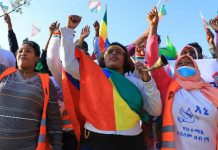Africa-Press-Ethiopia
thiopia’s multinational federal system was adopted in 1995 by the Ethiopian People’s Revolutionary Democratic Front (EPRDF) government primarily to try and end conflict among Ethiopia’s ethnic groups.
Implemented to institutionalize Ethiopia’s ethnic diversity and protect the integrity of the state, the constitution divided the country into administrative tiers: the federal government, regional states (kilils), zones, districts (weredas), and also the village areas (kebeles) inherited from the Derg.
This provided for top-down decentralization with the expectation that lower tiers of government would gradually acquire political and fiscal decision-making autonomy.
The implementation of a power-sharing arrangement involving the formation of nine ethnically self-administered states from a highly heterogeneous and dynamic society, a move to protect the rights and freedoms of the “nations, nationalities and peoples” of Ethiopia, subsequently dominated public debate.
This was partly because the states’ territorial and administrative boundaries in places fell short of reflecting Ethiopia’s ethnic diversity, and rather exacerbated exclusionist politics. It is a complex and heated debate, but solutions to Ethiopia’s social and economic problems are dependent on this power-sharing conundrum and its resolution.
When Abiy Ahmed was appointed as the Prime Minister in 2018, his government promised democratic reforms and the ending of poverty by unlocking Ethiopia’s economic potential. Indeed, the current transition and Abiy’s rise to power were driven in part by economic grievances arising from the unresolved problems of the federal system.
It seems clear that despite having shown a strong track record of economic growth, Ethiopia still needs to address structural economic defects and improve the federation’s functioning in order to move towards political stability. From this perspective Ethiopia’s Homegrown Economic Reform is good news—but only if it can successfully address uneven regional development patterns and wealth distribution.
Fiscal federalism theory
Federalism combines self-rule and shared rule, with the territorial, political, and fiscal power-sharing structures divided, but linked. Fiscal federalism or fiscal decentralization is a branch of public economic theory that analyses which fiscal functions (concerning expenditure) and instruments (concerning revenue collection) should be centralized and which are best decentralized and to what extent. The aim is to achieve optimal utilization of resources to produce sustainable growth.
The fiscal relationship between a federal government and the lower levels of administration, defined by the division of these functions and instruments, is institutionalized by an agreed tax system. In theory, expenditure for macroeconomic stabilization and redistribution functions is normally assigned to the federal government and revenue allocation for public services (e.g. allocation of income to different sectors such as health, education, or agriculture) to lower levels.
However, unless there is a mutually agreed arrangement to allow local governments to determine their revenue sources, a central government tends to take a more centralized fiscal approach. This appears as a decentralization of expenditure, but not revenue collection. It means that lower tiers of government can decide how they allocate federal transfers to different economic sectors but lack the autonomy to decide upon the tax sources or the share of revenue going to the federal government.
Citizens prefer policies that maximize local revenue generation and promote sustainable use of funds. But this requires a principle of subsidiarity to be respected and enforced within a federation, as the multilevel governance system allows for local government to be closer to the people, and arguably be more efficient and responsive to citizens’ needs.
Fiscal federalism practice
The process of decentralization—the devolution of political and fiscal decision-making powers from the central government to regional states—began in 1991 and was institutionalized by the 1995 constitution. The District Level Decentralization Program to promote local self-governance and improve service delivery, for example, was launched in 2001 in Tigray to deepen decentralization, transferring fiscal and political powers, instruments, and resources from the regional state to zones and district administrations.
This was followed by a pilot project in Amhara, Oromia, Southern Nations Nationalities and Peoples (Southern Nations), and Somali regional states allowing districts to implement economic plans based on locally determined priorities.
While fiscal decentralization may have begun over 25 years ago, Ethiopia hasn’t yet achieved its intended core objectives. Despite being one of the fastest-growing countries in sub-Saharan Africa in recent years, the poorest sectors of society have been unable to benefit evenly from poverty-reduction mechanisms, such as better infrastructure, job availability, or agriculture assistance.
The goal of promoting local self-governance has not been fully met either.
Decentralization was implemented by EPRDF as a mechanism to rule Ethiopia through its respective disciplined party administrations. In the attempt to reconcile the previous government’s authoritarian nature with a multinational federation, fiscal decentralization was a tool to deflate secessionist demands; a short-term solution to Ethiopia’s existential questions.
There is, however, an overarching problem that has prevented the benefits of decentralization manifesting in Ethiopia, and, if not addressed, could very well hinder the positive impact of the economic reform. This is the lack of a clear and comprehensive legal framework to define the fiscal responsibilities and powers of the federal government vis-a-vis other administrative tiers.
One of the legacies of all previous regimes in the country is the highly bureaucratic administration, which still today made transparency and accountability of government expenditure and economic processes very opaque. In fact, public access to key fiscal information remains very low.
This could explain why EPRDF’s imposed top-down devolution of political and fiscal powers, meant to improve the government’s ability to deliver public services, failed to ripple down to lower tiers of government, and, arguably, contributed to chronic poverty remaining a big issue.
Even when administrative devolution takes place, it is not always followed by a devolution of decision-making powers. This further prevents local governments from controlling their economic aspirations and resource use.
The federal constitution has surprisingly little to say about fiscal matters.
Articles 94 and 95 stipulate that “the federal government and the states shall respectively bear all financial expenditures necessary to carry out all responsibilities and functions assigned to them by law” and “share revenue taking the federal arrangement into account.”
Since there is no clear division between the responsibilities of zones and district administrations, zones, often without fiscal autonomy, interfere by assigning unelected officials or civil servants to woreda administrations and sectors. It is true that district administration divisions no longer operate along ethnolinguistic lines, but they face challenges to redress zero-sum games played by locally elected officials.
Articles 96 and 97 determine the division of taxation powers. Article 98 states that the federal government and the regional states can jointly collect taxes of shared tax sources, but the federal government’s revenue generating power is higher than the states because it holds on to the bigger sources of revenue.
Article 100 attempts to define rules to prevent taxation negatively affecting the regional states, demanding, for instance, that taxes, should be “determined following proper considerations”; a statement that falls far short of understanding historical marginalization of the periphery. Nor, in practice, is the divide between federal and regional governments’ tax powers sufficiently clear.
Given the EPRDF’s controlling modus operandi, it is probable that the government coalition never planned to grant fiscal autonomy to regional states or districts, instead seeing them as vehicles to implement centrally determined development plans. However, as regional states developed their own national identities as well as political interests and the federal government continued its covert centralizing tendencies, resource distribution increasingly became a contested area.
Ultimately, decentralization becomes meaningless if the tools to implement it are not respected. Albeit inconsistently, zonal and district level administrations do now have the authority to implement centrally crafted development plans and can coordinate diverse development strategies, but they remain dependent on the resources transferred from the centre because their revenue-collection capacity has not significantly improved.
Certainly, as supporters of federalism frequently argue, Ethiopia’s solutions need to go beyond detangling the dichotomy of decentralized versus centralized economic and political structures.
It is rather that Ethiopia needs to overcome the legacies of the partisan realities that have so far prevented any genuine devolution of political and fiscal powers to the regional states. To improve people’s standard of living, local officials need to prioritize effective and equitable service delivery to all citizens under their jurisdiction.
Resulting tensions
For instance, in Dire Dawa, a city disputed by Oromo and Somali and their regions, competition for resources has taken on an identity dimension as identities have been reshaped to alter the demographic composition of the city to match the 2006 power-sharing formula 40:40:20 (political leadership is divided among Somalis, Oromos, and other ethnic groups, respectively).
In early 2019, protests were held to demand the end of this quota system claiming that it does not reflect the city’s evolving ethnic diversity. The problem of this power-sharing arrangement is that it does not take into account the city’s fast population growth that could alter the ethnic composition, nor the importance of regular elections that grant legitimacy to the arrangement.
Council elections for Dire Dawa have been postponed twice. In 2019, the National Electoral Board of Ethiopia (NEBE) could not hold them as the election preparation was behind schedule. In 2020, elections were postponed due to the COVID-19 pandemic. In June 2020, the government will try to organize both the Dire Dawa and the national elections amid general political instability.
Across the Oromia-Somali border violence has been intermittently showing the effect of not fully demarcated boundaries. In an attempt to re-define internal borders, some groups have been forced to renounce their identities and assimilated into larger identity groups. This issue, not exclusive to this area, has manifested in forms of inter-communal violence over land ownership and access to resources and contributed to high numbers of internal displacement.






